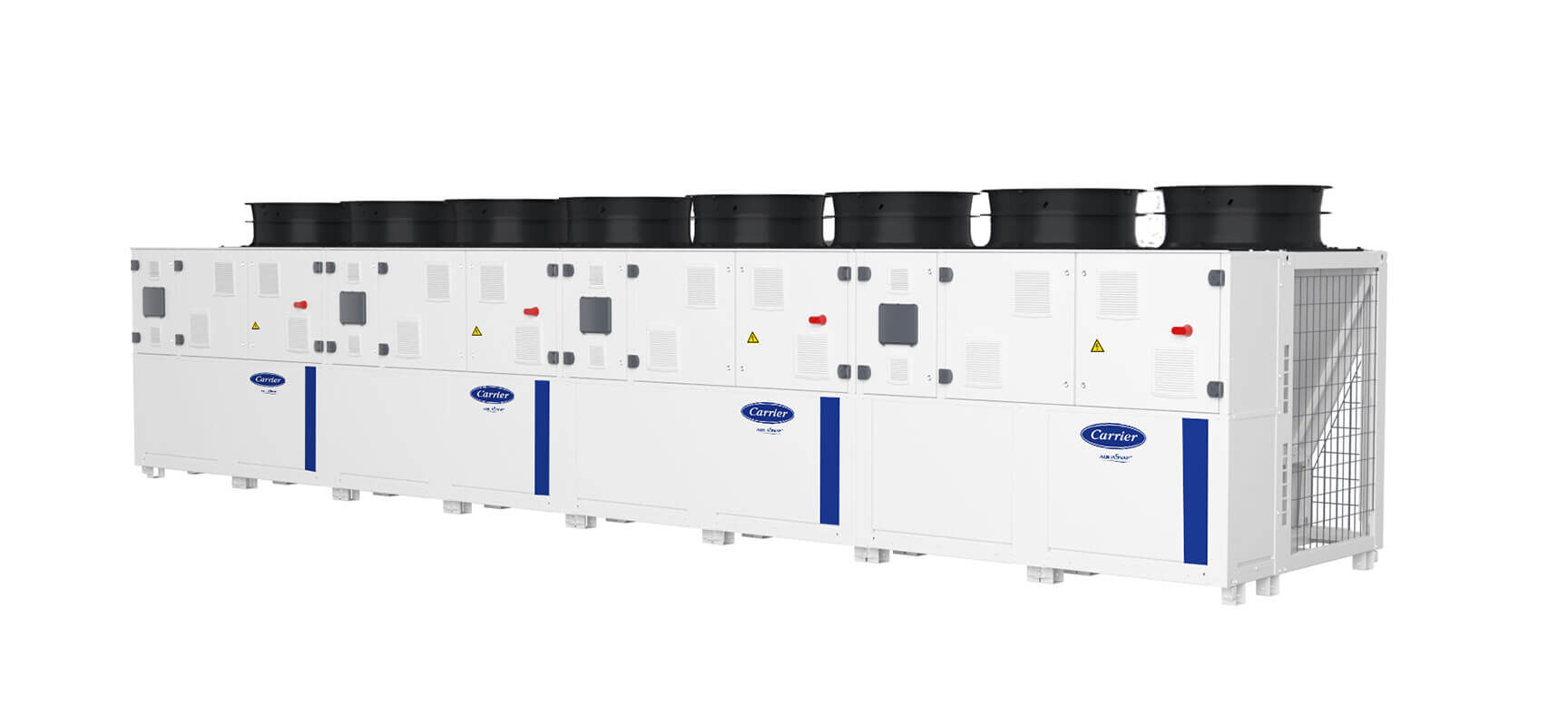
Carrier R-290 High-Temperature Heat Pump
A Sustainable Heating Solution
Breaking News: Carrier Announces R-290 High-Temperature Heat Pump
Carrier has announced the launch of the Carrier R-290 High-Temperature Heat Pump, a cutting-edge solution for enhanced energy efficiency and sustainability. This innovative heat pump utilises R-290 refrigerant (propane), a low Global Warming Potential (GWP) alternative, making it an eco-friendly option for heating systems. With the ability to provide water temperatures of up to 75°C, it is ideal for retrofitting into existing systems and supporting large-scale decarbonisation projects.
The Carrier High-Temp Heat Pump represents a significant advancement in sustainable heating technology. This innovative solution is specifically designed to meet the growing demand for energy-efficient heating systems with minimal environmental impact. Moreover, as organisations face increasing pressure to reduce carbon emissions, this technology offers a viable pathway to achieve sustainability goals without compromising on performance.
By implementing the Carrier High-Temp Heat Pump, businesses can significantly reduce their reliance on fossil fuels. Additionally, this cutting-edge technology delivers consistent high-temperature heating while minimising operational costs over time.
Why the Carrier High-Temp Heat Pump is Revolutionising Commercial Heating
The Carrier High-Temp Heat Pump stands at the forefront of heating innovation in the commercial sector. Its introduction comes at a critical time when businesses are actively seeking solutions to reduce their environmental footprint without sacrificing performance. Furthermore, this advanced system addresses the limitations that previously prevented heat pumps from fully replacing traditional boilers in certain applications.
What makes the Carrier High-Temp Heat Pump particularly revolutionary is its ability to deliver high temperatures while maintaining impressive efficiency levels. Consequently, it opens up possibilities for heat pump technology in sectors that previously relied exclusively on fossil fuel heating systems.
The system’s versatility means it can serve multiple purposes within a commercial setting, from space heating to providing hot water for various processes. Therefore, organisations can streamline their heating infrastructure while simultaneously advancing their sustainability agenda.
Understanding the Carrier High-Temp Heat Pump Technology
The Carrier High-Temp Heat Pump utilises advanced R-290 refrigerant (propane) technology to deliver exceptional heating performance. This natural refrigerant has an extremely low Global Warming Potential (GWP), making it an environmentally responsible choice compared to traditional refrigerants. Furthermore, this innovative approach allows the system to achieve water temperatures of up to 75°C, which is particularly impressive for a heat pump solution.
What sets the Carrier High-Temp Heat Pump apart is its ability to maintain high efficiency even when producing these elevated temperatures. Consequently, it becomes an ideal solution for retrofitting into existing heating systems that previously relied on conventional boilers.
The technology behind this system represents years of research and development by Carrier, a globally recognised leader in HVAC solutions. As a result, users benefit from both cutting-edge innovation and proven reliability.
Key Benefits of Implementing the Carrier High-Temp Heat Pump
Organisations considering the Carrier High-Temp Heat Pump can expect numerous advantages:
- Superior Energy Efficiency: The system converts ambient energy into usable heat with remarkable efficiency, resulting in lower energy consumption compared to traditional heating methods.
- Significant Carbon Reduction: By using R-290 refrigerant and reducing energy use, the system dramatically lowers carbon emissions.
- Versatile Application: The heat pump can be integrated into various commercial and industrial settings, from schools to hospitals and manufacturing facilities.
- Long-term Cost Savings: Despite the initial investment, reduced operational expenses deliver substantial savings over the system’s lifetime.
- Future-proof Compliance: As regulatory requirements for carbon reduction become stricter, this system ensures organisations stay ahead of compliance demands.
The economic benefits become particularly apparent when considering total cost of ownership. In fact, many organisations report payback periods of just a few years, after which the Carrier High-Temp Heat Pump continues to deliver ongoing savings.
How the Carrier High-Temp Heat Pump Supports Decarbonisation Goals
Decarbonisation has become a priority for organisations across the UK, particularly with the government’s Net Zero targets. The Carrier High-Temp Heat Pump directly addresses this challenge by offering a practical alternative to fossil fuel heating. In addition, its high temperature capabilities make it suitable for applications that traditionally required gas or oil boilers.
Local authorities implementing large-scale decarbonisation projects find the Carrier High-Temp Heat Pump particularly valuable. For instance, the technology can be integrated into district heating networks, providing efficient heating to multiple buildings from a central plant room.
By replacing conventional heating systems with this advanced heat pump technology, organisations can achieve carbon reductions of up to 80% compared to gas boilers. Therefore, it represents one of the most effective measures available for meeting ambitious sustainability targets.
Ideal Applications for the Carrier High-Temp Heat Pump System
The versatility of the Carrier High-Temp Heat Pump makes it suitable for diverse applications:
- Educational Facilities: Schools and universities benefit from consistent heating with lower running costs and reduced environmental impact.
- Healthcare Settings: Hospitals and care homes require reliable heating solutions that maintain comfortable temperatures while controlling operational expenses.
- Commercial Buildings: Office complexes and retail environments can meet sustainability targets without compromising occupant comfort.
- Industrial Processes: Manufacturing facilities with high-temperature water requirements can reduce carbon emissions while maintaining production efficiency.
- Public Sector Buildings: Government facilities can demonstrate leadership in sustainability while optimising budgets through reduced energy costs.
Each of these sectors faces unique challenges in balancing operational requirements with environmental responsibilities. Fortunately, the Carrier High-Temp Heat Pump offers the flexibility to address these diverse needs effectively.
Technical Specifications of the Carrier High-Temp Heat Pump
Understanding the technical aspects of the Carrier High-Temp Heat Pump helps organisations determine its suitability for specific projects. The system delivers water temperatures up to 75°C, making it compatible with existing radiator systems designed for traditional boilers. Additionally, it maintains efficiency even in challenging ambient conditions, with effective operation down to -20°C external temperatures.
The use of R-290 refrigerant not only reduces environmental impact but also enhances system performance. Furthermore, the heat pump incorporates advanced controls that optimise operation based on demand and external conditions, maximising efficiency throughout the year.
Available in various capacities, the Carrier High-Temp Heat Pump can be scaled to meet the requirements of different project sizes. As a result, it offers a flexible solution that can be tailored to specific heating demands and spatial constraints.
Integration Considerations for the Carrier High-Temp Heat Pump
When implementing the Carrier High-Temp Heat Pump, several factors require careful consideration:
- System Sizing: Proper sizing ensures optimal performance and efficiency, avoiding issues with under or over-capacity.
- Hydraulic Integration: The heat pump must be correctly integrated with existing or new distribution systems to maximise performance.
- Control Strategy: Developing an effective control strategy optimises operation and ensures the system responds appropriately to changing conditions.
- Supplementary Heating: For extremely cold conditions, considering backup heating options may be necessary to maintain capacity.
- Noise Considerations: While generally quiet in operation, placement should consider acoustic impact, particularly in sensitive environments.
Working with experienced professionals ensures these considerations are properly addressed. Consequently, the system delivers its full potential in terms of performance, efficiency, and reliability.
Comparing the Carrier High-Temp Heat Pump to Alternative Solutions
When evaluating heating options, organisations often compare the Carrier High-Temp Heat Pump to conventional alternatives. Traditional gas boilers, while familiar, increasingly face challenges related to carbon emissions and future-proofing against regulatory changes. In contrast, the Carrier High-Temp Heat Pump offers a sustainable path forward with comparable performance capabilities.
Compared to standard heat pumps, the high-temperature variant provides significant advantages when retrofitting existing buildings. The ability to deliver 75°C water means radiators and distribution systems can often remain unchanged, substantially reducing project costs and disruption.
Other renewable options such as biomass boilers or hydrogen systems each have their place, but the Carrier High-Temp Heat Pump offers advantages in terms of operational simplicity, space requirements, and proven technology. Furthermore, it requires minimal maintenance compared to combustion-based systems.
Funding and Support for Carrier High-Temp Heat Pump Projects
Organisations considering the Carrier High-Temp Heat Pump can access various support mechanisms. Government incentives often apply to high-efficiency heating systems, potentially reducing the initial investment required. Additionally, energy efficiency financing programmes can help spread costs while immediate operational savings begin to accumulate.
Many local authorities have established specific funding streams for decarbonisation projects, particularly for public buildings and community facilities. Furthermore, some utility companies offer incentives for businesses transitioning to low-carbon heating solutions.
Working with experienced providers ensures organisations identify and access all available support. Consequently, the financial case for implementing the Carrier High-Temp Heat Pump becomes even more compelling.
Conclusion: Why the Carrier High-Temp Heat Pump Represents the Future of Sustainable Heating
The Carrier High-Temp Heat Pump stands at the forefront of heating technology, offering a practical solution to contemporary challenges. By delivering high-temperature output with minimal environmental impact, it addresses both performance requirements and sustainability objectives.
As regulations around carbon emissions continue to tighten, forward-thinking organisations are already transitioning to technologies like the Carrier High-Temp Heat Pump. This proactive approach not only ensures compliance but also delivers significant operational benefits and cost savings.
For organisations committed to sustainable operations without compromising performance, the Carrier High-Temp Heat Pump represents an ideal solution. Therefore, consulting with specialists about integrating this technology into your heating strategy is a wise step toward a more sustainable and efficient future.
